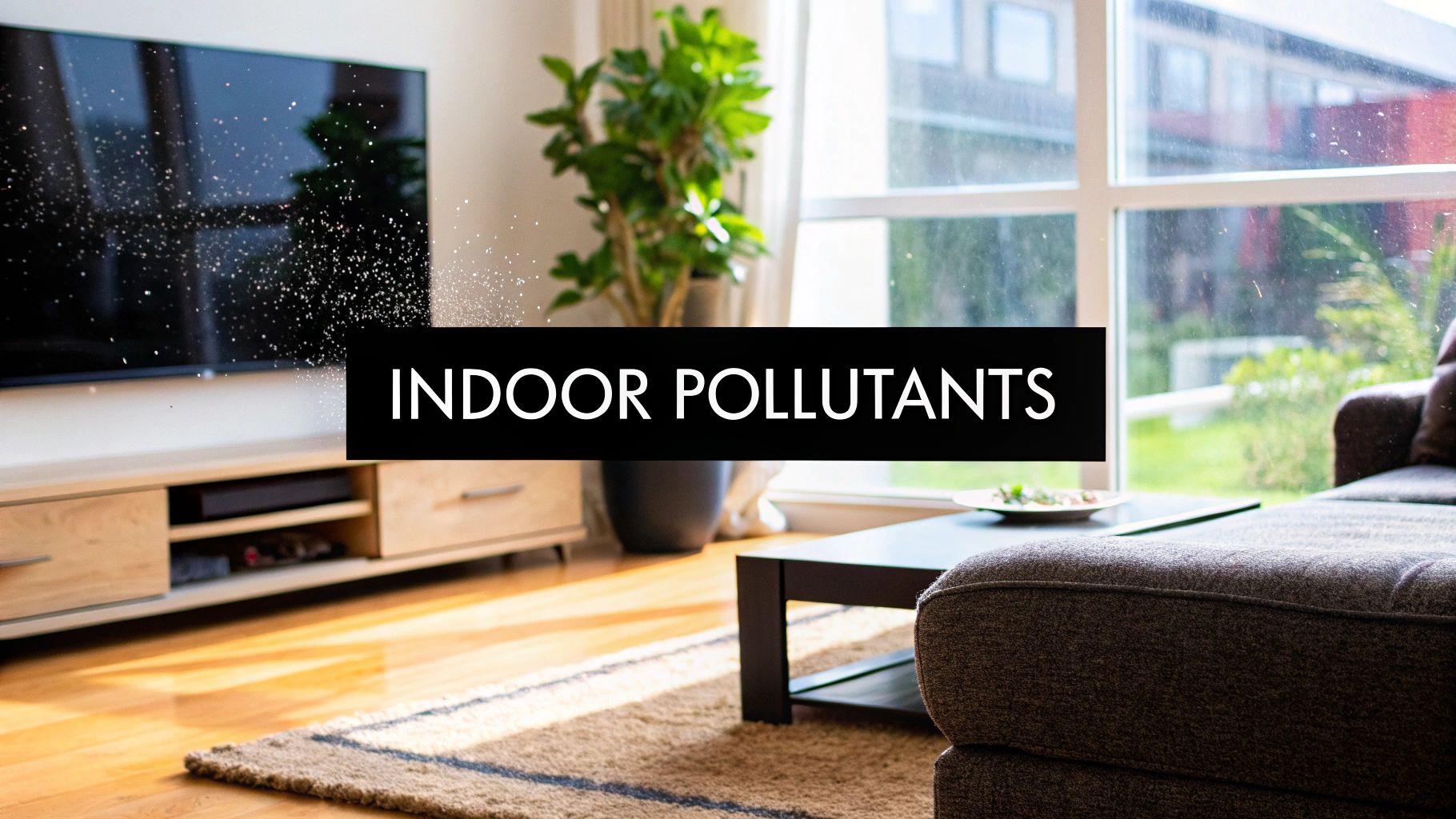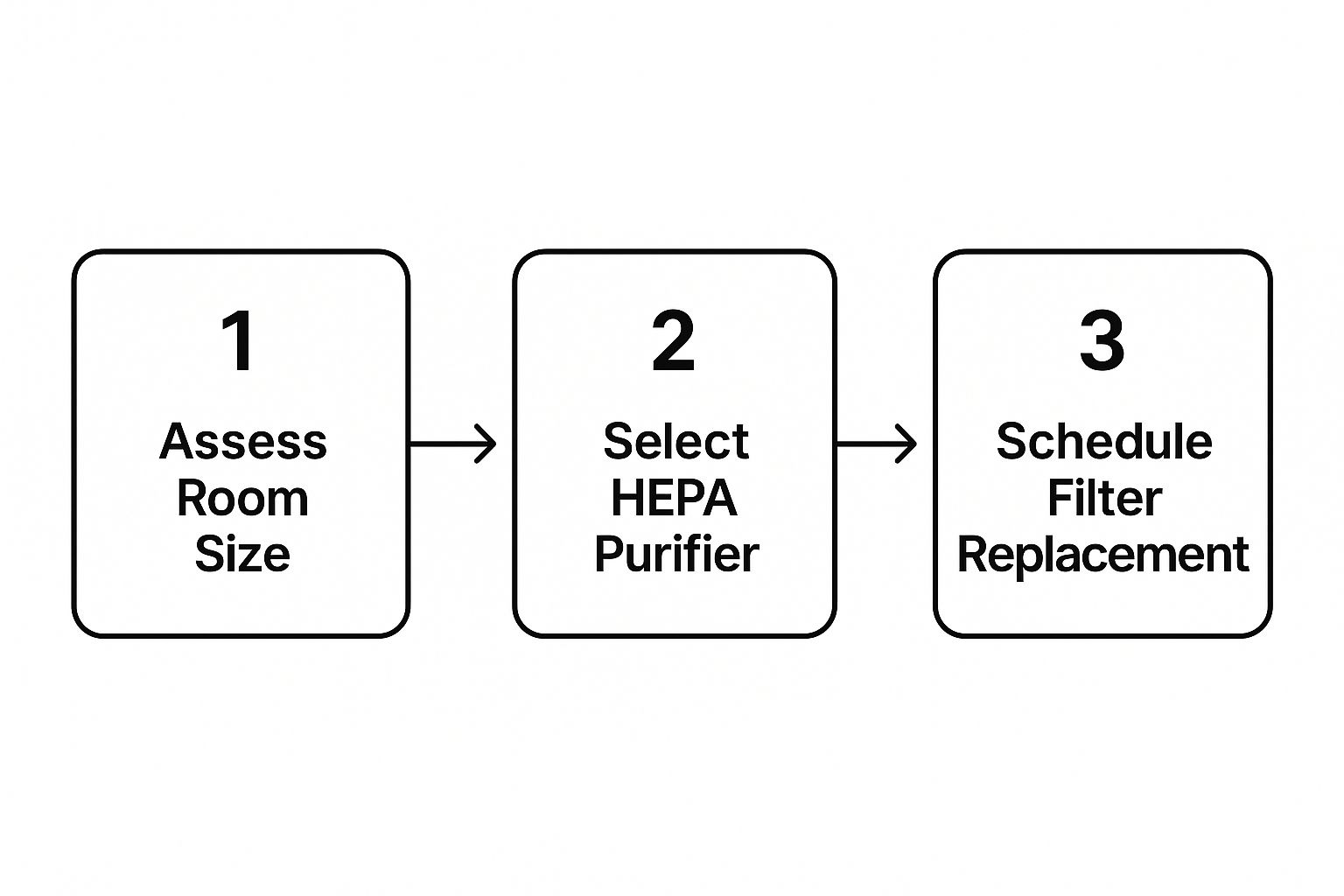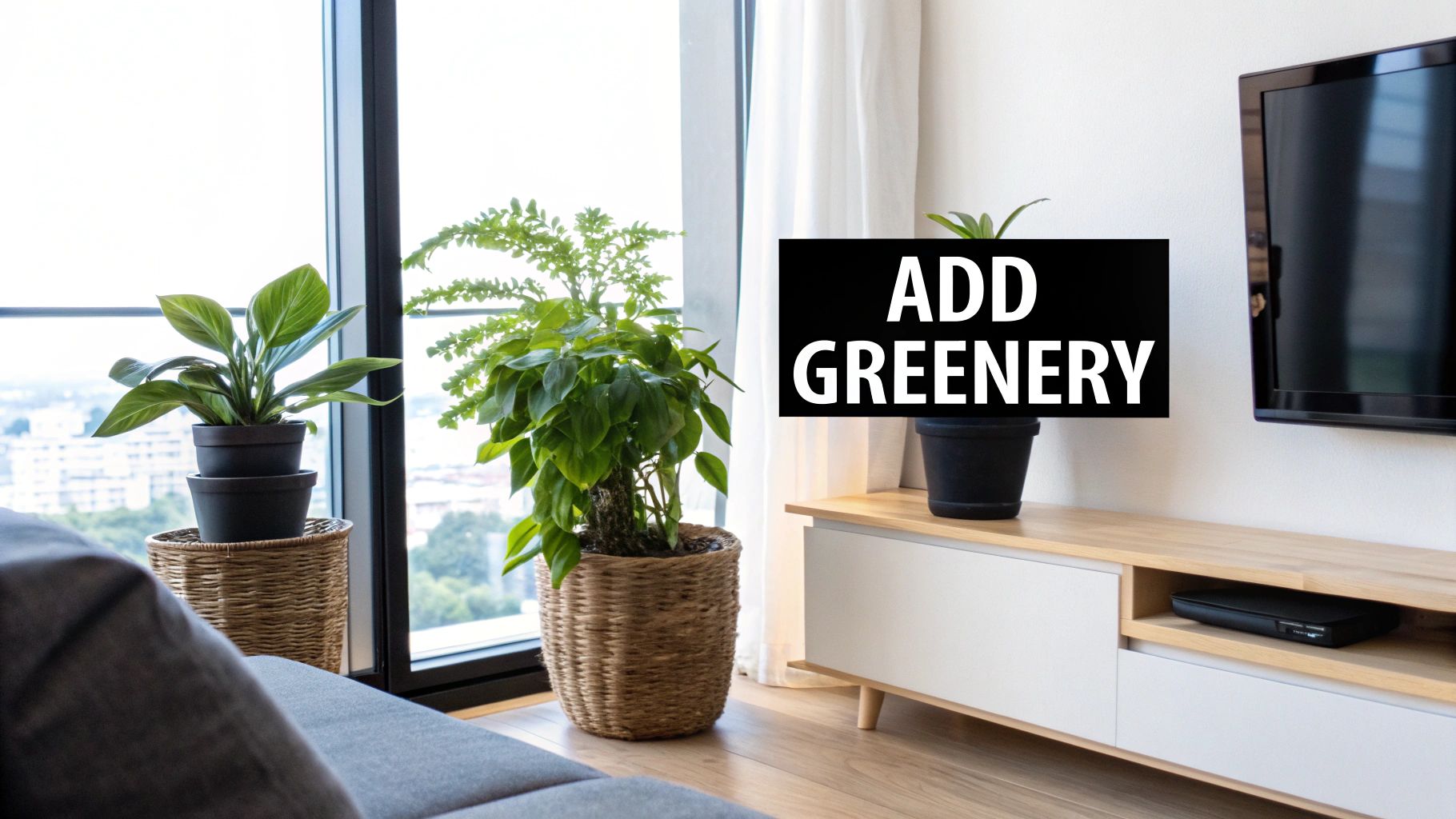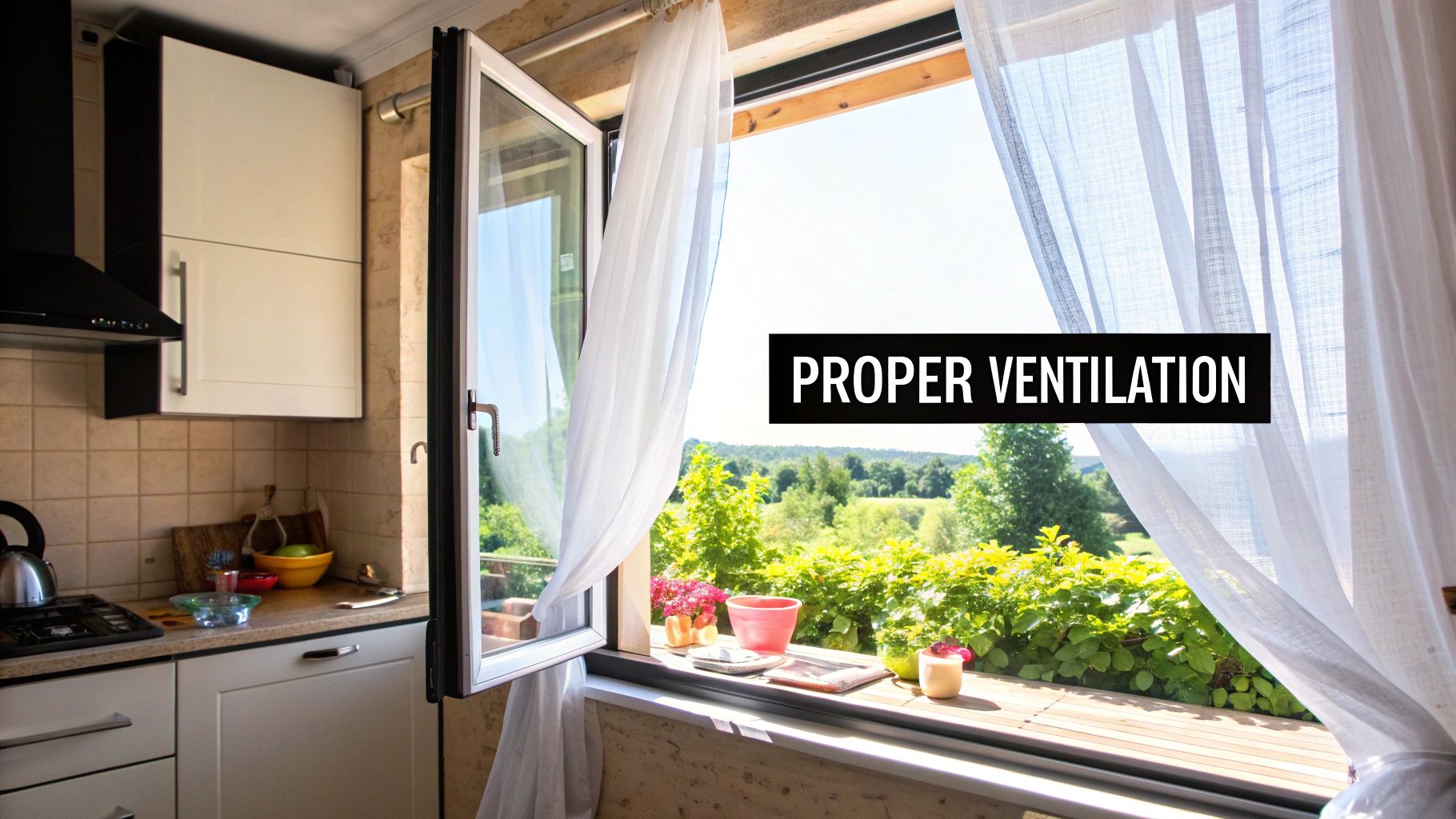Improve Indoor Air Quality: Simple Tips for a Healthier Home
- shawnpurifiedair
- Jul 28
- 14 min read
Updated: Aug 8
If you want to genuinely improve the air quality inside your home, you first have to figure out what's making it bad to begin with. It's about more than just cracking a window open. You have to identify and tackle the hidden pollutants, things like dust, allergens, and chemicals, that quietly build up in your living spaces. By taking a few smart steps to ventilate, filter, and control these sources, you can create a home that feels and is healthier.
Why Your Indoor Air Quality Really Matters

We tend to think of air pollution as an outdoor problem, that hazy smog hanging over a city. But here’s the kicker: the air inside our homes can actually be far more polluted than the air outside. Since most of us spend between 60% and 90% of our lives indoors, our exposure to these concentrated pollutants is nearly constant.
This isn’t a small problem. Poor indoor air is a massive global health issue, contributing to an estimated 3.2 million premature deaths worldwide each year as of 2025.
The Invisible Threats in Your Home
So, what’s fouling up the air? A lot of it comes from everyday items and activities that release invisible pollutants. These contaminants can trigger everything from minor irritations to much more serious, long-term health conditions. Pinpointing these sources is the first real step toward breathing easier.
To get a clearer picture, let's look at some of the most common culprits lurking inside your home.
A Quick Guide to Common Indoor Air Pollutants
This table breaks down the typical pollutants we find in homes, where they come from, and how they can affect your health.
Pollutant | Common Sources | Health Impact |
|---|---|---|
Volatile Organic Compounds (VOCs) | New furniture, paint, cleaning products, air fresheners, flooring | Headaches, dizziness, nausea, long-term liver or kidney damage |
Airborne Allergens | Dust mites, pet dander, pollen, cockroach droppings | Sneezing, coughing, itchy eyes, asthma flare-ups, allergic reactions |
Mold and Mildew | Damp basements, leaky pipes, bathrooms, poorly ventilated kitchens | Respiratory infections, coughing, wheezing, throat irritation |
Combustion Gases | Gas stoves, water heaters, fireplaces, attached garages | Fatigue, confusion, headaches, carbon monoxide poisoning (at high levels) |
Recognizing these troublemakers is key to clearing your air.
The connection is clearer than you might think. Those persistent headaches, that nagging fatigue, or allergies that just won't quit? They aren’t always random. Often, they're direct signals from your body that the air you're breathing every day is compromised.
Taking control of your indoor air is a direct investment in your well-being. By focusing on a few targeted actions, you can systematically reduce these threats. For a full breakdown of what to do next, check out our complete guide to improving indoor air quality, which offers practical steps for every room in your house.
Mastering Home Ventilation and Air Circulation
Improving your home's ventilation is your first and most powerful line of defense against stale, polluted indoor air. When people hear "ventilation," they usually think of just cracking a window open. But a more deliberate approach can make a world of difference, constantly flushing out pollutants and pulling in fresh air.
It’s all about creating consistent airflow. Without it, airborne junk like dust, allergens, and nasty VOCs (volatile organic compounds) from your furniture and cleaning supplies just get trapped. They build up over time to unhealthy levels. Proper circulation is like giving your home a set of lungs; it continuously breathes out the bad and breathes in the good.
Put Your Home’s Built-In Systems to Work
Your house probably already has some powerful ventilation tools built right in; you just need to start using them correctly. I’m talking about your kitchen and bathroom exhaust fans. They aren’t just for getting rid of funky smells or steam, they are designed to pull polluted air directly out of your home.
Get into the habit of running your kitchen exhaust fan every single time you cook, not just when you've accidentally set off the smoke alarm. For your bathroom, run the fan during your shower and for about 15 to 20 minutes afterward. This simple change yanks out all that moisture that would otherwise feed mold growth and gets rid of pollutants from your personal care products.
So many people I talk to completely neglect these fans. They are your direct pipelines for exporting indoor pollution. Using them consistently is one of the most impactful, no-cost habits you can build for better air quality, starting today.
Get Smart with Cross-Ventilation
Beyond your exhaust fans, you can use a little bit of basic physics to your advantage. Creating cross-ventilation is an incredibly effective way to cycle the air through your entire home. It’s as simple as opening windows on opposite sides of your house to create a current that literally pushes stale air out and sucks fresh air in.
Want to supercharge it? Place a simple box fan in one window, facing out, to actively push the old air outside. Then, crack open a window in another room to let clean, fresh air get pulled in to replace it. This creates a far more powerful air exchange than just leaving one window open and hoping for the best.
Of course, you’ll want to be strategic about when you do this.
Check the Outdoor Air: Before you throw open the windows, take a look at a local air quality app like AirNow or Plume Labs. You'll want to air out your home when pollen counts and pollution levels are at their lowest, which is often in the early morning or later in the evening.
Dodge Rush Hour: If you live near a busy road, keep those windows shut during peak traffic times. The last thing you want is to pull a lungful of vehicle exhaust into your living room.
Be Seasonally Aware: During peak pollen season, a great time to air out your home is right after a rain shower. The rain helps wash all those allergens out of the air, giving you a window of opportunity for cleaner fresh air.
Seal the Gaps Where Pollutants Sneak In
While you're creating intentional ways for fresh air to get in, you also need to block the unintentional entry points. Tiny air leaks around your windows, doors, and where utility lines enter your home are like secret backdoors for outdoor pollutants, allergens, and moisture.
Take a walk around your home and inspect these common trouble spots. You can easily seal most gaps with weatherstripping for doors and a bit of caulk for window frames. It's a small weekend project that pays off big. Not only will you keep unwanted junk out of your air, but you'll also make your home more energy-efficient and probably save a few bucks on your heating and cooling bills.
Choosing the Right Air Filtration System
Once you've improved your home's ventilation, the next big win for your indoor air quality is filtration. But let's be honest, trying to figure out air filters and purifiers can feel like learning a new language. You're hit with terms like MERV, HEPA, and activated carbon, and it’s easy to feel completely lost. Let's cut through the noise and talk about what you actually need to know to make a smart choice.
Your first line of defense is usually your home's own HVAC system. The filter tucked inside is meant to capture particles, but they aren't all created equal. Their power is measured by a MERV rating, which stands for Minimum Efficiency Reporting Value, on a scale from 1 to 20. The higher the number, the smaller the particles it can trap.
Decoding Filter Types and Ratings
For most homes, a filter with a MERV rating between 8 and 13 is the sweet spot. It does a great job of nabbing common annoyances like dust mites, pollen, and mold spores without choking your HVAC system's airflow. That's a key point: before you upgrade, always check your system's manual. Some older units just can't handle the density of a high-MERV filter and will struggle.
Now, if you're dealing with specific health concerns, a portable air purifier is a fantastic ally. These units are built to clean the air in a single room, which makes them perfect for bedrooms or living areas where you clock the most hours.
The gold standard for these portable units is the HEPA filter, which means High-Efficiency Particulate Air.
A true HEPA filter is certified to capture an incredible 99.97% of airborne particles as tiny as 0.3 microns. To give you some perspective, a single human hair is about 50 microns thick. That's why HEPA filters are so good at removing pet dander, smoke, viruses, and other microscopic gunk that sets off allergies and asthma.
Another feature to look for is an activated carbon filter. While HEPA filters are particle-capturing machines, activated carbon is what goes after gases, odors, and those nasty VOCs from things like cleaning supplies or new furniture. Many of the best purifiers will have both.
Making the Right Choice for Your Home
Let's walk through a real-world scenario I see all the time: a family with a golden retriever and a child with asthma.
Their first move is to check their HVAC system. They learn it can handle a MERV 11 filter, so they pop one in to start capturing pet dander throughout the entire house. But for their child's bedroom, where clean air is non-negotiable overnight, they bring in a portable air purifier with both a HEPA and an activated carbon filter. This one-two punch traps the dander the main system might miss and also absorbs irritants that could trigger an asthma attack.
Before you buy anything, it's always a good idea to know exactly what you're up against. You can get a clearer picture by reading up on your guide to a home air quality test.
This infographic gives a simple flow for picking the right purifier for any room.

The pollution outside our homes makes having strong indoor filtration even more critical. In the United States, nearly 131 million people live in counties with failing air quality grades, according to the 2025 State of the Air Report. That outdoor pollution doesn't stay outdoors; it seeps inside and mixes with everything else, which just highlights why effective filtration is no longer a luxury. You can see the full report on the state of our air from the American Lung Association to get a better sense of the bigger picture.
Reducing Pollutants Directly at the Source

While ventilation and filters do a great job cleaning up existing problems, the most powerful way to improve your indoor air is to stop pollutants from getting inside in the first place. This strategy is all about source control, making smarter, more conscious choices in your daily life. It’s a proactive approach that tackles pollution before it even gets a chance to start circulating.
Think of it like this: it's far easier to avoid spilling something on the floor than to clean up a huge mess afterward. So many common household items and daily routines are constant sources of indoor pollution, from the products you clean with to the furniture you relax on. By making just a few key changes, you can shut off these pollution streams right at the source and create a fundamentally healthier space to live.
Start in the Heart of the Home: The Kitchen
The kitchen is often ground zero for indoor pollutants, mainly from cooking fumes and cleaning chemicals. Every time you cook, especially on a gas stove, you're releasing particulate matter and combustion gases like nitrogen dioxide. The solution is simple but absolutely crucial: use your range hood fan every single time you cook.
It’s not just for smoke; it captures the invisible pollutants, too. Next, take a look under your sink. Many traditional cleaners are packed with harsh chemicals that evaporate into the air. Switching to non-toxic, unscented cleaning products or even simple solutions like vinegar and water can dramatically cut down on the chemical load in your kitchen's air.
The products we bring into our homes have a direct and immediate impact on the air we breathe. A simple choice, like opting for a low-VOC paint or a natural fiber rug, isn't just an aesthetic decision; it's a health decision that pays dividends every single day.
Re-Evaluating Your Living Spaces
Your living room and bedrooms are where you spend most of your time, so making smart choices here is critical. Many modern furnishings, paints, and carpets release Volatile Organic Compounds (VOCs) into the air through a process called off-gassing. These are the chemicals responsible for that "new car" or "new furniture" smell, and they can cause headaches, dizziness, and other irritations.
Here are a few high-impact changes to consider:
Choose Low-VOC or No-VOC Products: When you're painting or buying new furniture, make a point to look for items labeled "low-VOC" or "no-VOC." This simple check can prevent a major source of chemical pollution from ever entering your home.
Opt for Natural Fibers: Synthetic carpets and rugs are often treated with a cocktail of chemicals. Instead, consider rugs made from natural fibers like wool, cotton, or jute, which are much healthier alternatives.
Be Mindful of Dry Cleaning: Those freshly dry-cleaned clothes can release chemicals into your closet and bedroom. A good habit is to let them air out in a well-ventilated space, like a garage or patio, for a day before bringing them inside.
Control Humidity to Prevent Mold
One of the most dangerous indoor pollutants is mold, which absolutely thrives in damp, humid conditions. High humidity doesn't just make your home feel sticky and uncomfortable; it creates the perfect breeding ground for mold and dust mites. Keeping moisture in check is key to preventing these allergens from taking hold. Using a dehumidifier in naturally damp areas like basements or bathrooms can keep humidity levels between a healthy 30% and 50%. You can learn more from our detailed guide on how to avoid mold in your home and damp buildings for more targeted strategies.
This proactive approach is part of a larger global effort to improve air quality. As of early 2025, a World Health Organization database revealed that 17% more countries now enforce standards for major pollutants like particulate matter and nitrogen dioxide. Learn more about these global air quality standards on who.int.
Go Green: Using Houseplants as Natural Air Purifiers

After tackling the man-made sources of pollution, let's talk about a more natural, living way to freshen up your indoor air. Bringing houseplants into your home is a fantastic way to supplement your other efforts. While a few potted plants won't single-handedly outperform a high-quality mechanical filter, they absolutely contribute to a healthier home and bring a welcome touch of nature indoors.
It all comes down to simple biology. Through a process called phytoremediation, plants naturally absorb gases and other substances through their leaves and roots. Certain common houseplants are surprisingly good at pulling airborne toxins right out of your air, toxins that constantly off-gas from everyday items in our homes. Some have been shown to reduce levels of formaldehyde and benzene, two very common VOCs found in things like furniture, paint, and even cleaning products.
Top Low-Maintenance Plants for Cleaner Air
You don’t need a green thumb to get started, I promise. Many of the most effective air-purifying plants are also the most forgiving. They can handle a bit of neglect and still go to work improving your air quality, making them perfect for busy homeowners or novice plant parents.
Here are a few resilient options I often recommend:
Snake Plant (Sansevieria trifasciata): This one is a superstar, especially for bedrooms, because it releases oxygen at night. It’s also incredibly effective at filtering out formaldehyde, xylene, and toluene.
Spider Plant (Chlorophytum comosum): Famous for being almost impossible to kill and easy to propagate, the spider plant is a workhorse against formaldehyde and carbon monoxide. It's a great pick for the kitchen or near a fireplace.
Peace Lily (Spathiphyllum): Not only does it have beautiful white flowers, but the peace lily is great at removing ammonia, benzene, and formaldehyde. It will even droop a little to let you know it’s thirsty, how helpful is that?
Pothos (Epipremnum aureum): Often called Devil's Ivy, this trailing vine is tough as nails and fantastic at clearing formaldehyde. It looks great in a hanging basket or placed on a high shelf.
Let’s be realistic, though. While plants are excellent natural filters, you would need a small jungle in your living room to match the air-cleaning power of a modern purification system. It’s best to think of them as a beautiful, natural sidekick to your primary filtration and ventilation strategies.
Beyond Plants: Other Natural Solutions
Improving your air naturally isn't just about adding greenery. A few other simple swaps can make a surprisingly big difference. For instance, those common paraffin wax candles? They can release soot and VOCs when burned. Switching to 100% beeswax or soy candles is a much healthier choice; they burn cleaner and produce far fewer pollutants.
Another easy win is ditching synthetic air fresheners. Plug-ins and aerosol sprays often just mask odors with a cocktail of chemicals. Instead, try an essential oil diffuser. A few drops of lavender or lemon oil can freshen the air naturally, without adding to your home's chemical load.
These natural solutions are powerful, but they work best when paired with modern technology. While plants and candles can handle some of the load, advanced systems are designed to neutralize the rest. To see how technology can destroy pathogens that plants can't, you can learn more about what an ActivePure air purifier is and how it creates a comprehensive clean-air strategy.
Your Air Quality Questions Answered
When you start digging into how to improve your home's air, questions always come up. It's only natural. Here, we'll tackle some of the most common ones I hear from homeowners, giving you straightforward answers so you can feel confident you're making the right moves for a healthier home.
How Can I Test My Indoor Air Quality?
The easiest place to start is with a good home air quality monitor. You can find affordable ones that track the big three: PM2.5 (those tiny, nasty dust particles), VOCs (chemicals from things like paint and cleaners), and carbon dioxide. Watching the real-time data from one of these gadgets is eye-opening, you’ll quickly see which rooms or activities are causing spikes.
If you have deeper worries, like a suspicion of mold or the presence of radon, don't guess. That's the time to call in the pros for an environmental test. They bring specialized equipment that gives you a detailed, scientific analysis, which is absolutely essential for dealing with serious health risks. If you're consistently noticing stuffy air or other symptoms, it's worth learning how to tell if your home or business has poor indoor air quality.
Are Air Purifiers With UV Lights Or Ionizers Effective?
This is a common question, and the answer isn't a simple yes or no. Air purifiers with UV-C lights can neutralize biological contaminants like bacteria and viruses, but there's a catch: the air has to be exposed to the light for a specific amount of time. The effectiveness really depends on the design and power of the unit.
Ionizers are a different beast. They release charged ions that attach to airborne particles, making them too heavy to stay afloat. They drop to the floor or stick to surfaces. The main concern here is that some ionizers can produce ozone as a byproduct, and ozone is a known lung irritant you definitely don't want in your home.
For most situations, a high-quality HEPA filter is still the gold standard. It's the safest and most proven technology for physically trapping particles. If you do go for a model with UV or ionization, do your homework and make sure it's certified not to produce harmful levels of ozone.
What Are The First Three Things I Should Do On A Budget?
Looking for the biggest bang for your buck? I get it. Not everyone can overhaul their HVAC system overnight. If you want to make a real difference without a major investment, here are the three things I always recommend starting with.
Make Ventilation a Habit: This one is completely free. Crack open your windows for at least 15 minutes every day to flush out stale air. Just as important, always run your kitchen and bathroom exhaust fans when cooking or showering. This pulls moisture and pollutants directly outside before they can spread.
Install a Better HVAC Filter: This is probably the single most effective, low-cost upgrade you can make. Check your HVAC system's manual to find the highest MERV-rated filter it can handle without straining the motor. Then, be religious about changing it on schedule.
Stop Pollutants at the Door: A "no shoes in the house" rule is surprisingly powerful. You’d be shocked by the amount of dirt, pesticides, and pollen that gets tracked in on the bottom of shoes. Pair that with a weekly vacuuming routine (using a vacuum with a HEPA filter, if possible) and you'll dramatically cut down on dust and allergens.
These simple habits don't cost much, but when done consistently, they create a powerful foundation for cleaner, healthier air in your home.
For a comprehensive approach to cleaner air, Purified Air Duct Cleaning offers professional air duct cleaning and installs advanced ActivePure® air purification systems. Ensure your home’s air is as clean as it can be by visiting us at https://www.purifiedairductcleaning.com.
